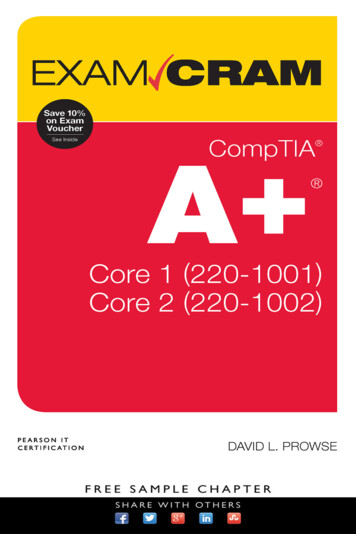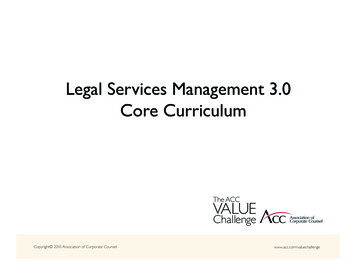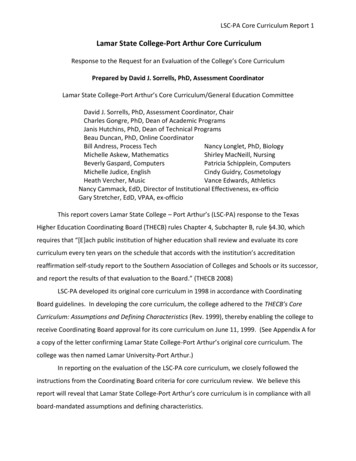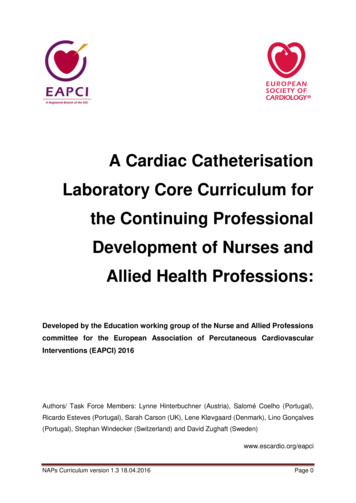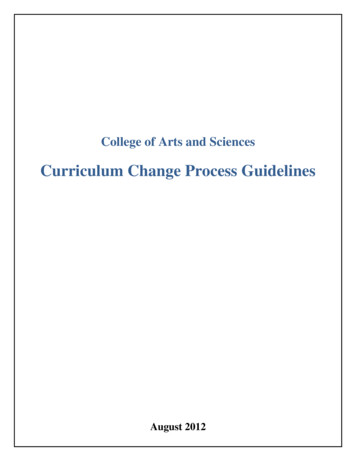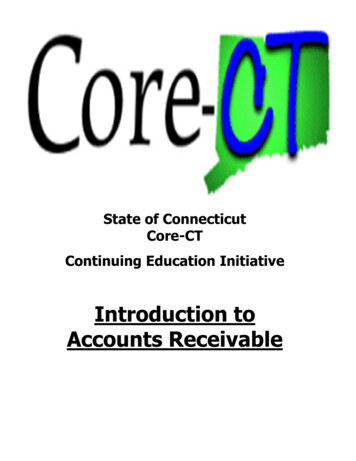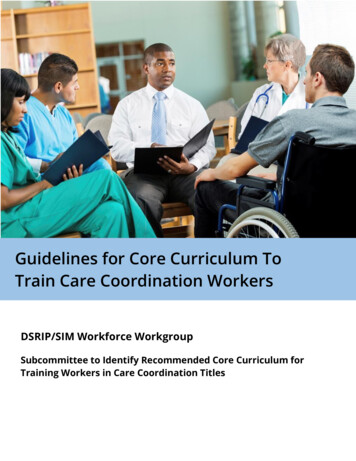
Transcription
Guidelines for Core Curriculum ToTrain Care Coordination WorkersDSRIP/SIM Workforce WorkgroupSubcommittee to Identify Recommended Core Curriculum forTraining Workers in Care Coordination Titles
Guidelines for Core Curriculum to Train Care Coordination WorkersThe DSRIP/SIM Workforce Workgroup recognized the need to identify consistent care coordinationtraining guidelines for all workers who provide care coordination services. A subgroup was formed,comprised of representatives of organizations that play leading roles in the State's workforce developmentefforts around care coordination education and training. These organizations and their representatives arelisted below: Center for Health Workforce Studies, Jean Moore and Bridget BakerJFK, Jr. Institute for Worker Education, City University of New York, Carrie Shockley and WilliamEbenstein,Fort Drum Regional Health Planning Organization, Tracy LeonardNew York Alliance for Careers in Healthcare, Shawna TragerState University of New York, Office of Academic Health & Hospital Affairs, Heather Eichin1199SEIU/League Training & Upgrading Fund, Sandi Vito, Becky Hall and Selena PittParaprofessional Health Institute, Carol RodatThe group worked together to identify key concepts in care coordination and shared and reviewed a widearray of care coordination training curricula, including: CUNY Credited Course Sequence in Care Coordination and Health CoachingHealthStream and the American Academy of Ambulatory Care Nursing (AAACN) CareCoordination and Transition Management (CCTM)Hudson Mohawk Area Health Education Center (AHEC) Care Management SkillsTraining/Adirondack Health Institute (AHI)New York Alliance for Careers in Healthcare Training- Core Competencies for Today’s HealthcareWorkforceNorth Country Care Coordination Certificate Program1199SEIU TEF and PCDC Care Coordination FundamentalsMost of these curricula were designed based on national literature reviews of care coordination trainingprovided around the country. There was a great deal of consistency in content across the differenttraining curricula reviewed. The group worked collaboratively to identify key concepts drawn fromthese curricula to serve as the basis for developing core curriculum guidelines that could be usedstatewide in training workers who provide care coordination services. The results of this effort aredetailed below, and include nine (9) modules that in the group’s opinion, represent core content for carecoordination training. Each module includes recommended topics with learning objectives and examplesof resources. Also included is a list of open-source resources and a bibliography of readings that cover awide array of topics relevant to care coordination training. These readings may be of particular use tocurriculum developers and trainers. Please note, the resources and bibliography of readings werecontributed by individuals who assisted in developing the guidelines as well as reviewers of theguidelines. The group recognizes that these reference materials represent a starting point and they are farfrom complete. Instead, they should be viewed as available material for trainers and others engaged inplanning care coordination training programs.This work represents recommended guidelines for care coordination training and could serve as a trainingbase for workers who provide care coordination services. However, the group agreed on the importance
of supporting flexible approaches to care coordination training. Specifically, the training content isdesigned to be adapted by trainers to account for factors such as education level and experience oftrainees, target populations (e.g., chronically mentally ill, children), setting, and geography (.i.e.,rural/urban variation). Components of the curriculum could also be integrated into the training of otherhealth workers, for example, home health aides, medical assistants, and community health workers.Consideration should also be given to training the supervisors of care coordinators to ensure a clearunderstanding of the roles and functions of care coordinators, based on this training.Standardized guidelines for care coordination training assures employers that their workers have aconsistent base of knowledge on care coordination and the services they provide. It can also support thedevelopment of stackable credentials and career mobility. Additionally, these modules could serve as abasis for credit bearing courses on care coordination provided by local colleges.
SUMMARYBelow is a summary of the nine (9) modules and accompanying learning topics that serve as the base fortraining workers who provide care coordination services. It is anticipated that, in all, these training modulesshould take between 36 and 45 hours to complete. Ultimately, the modules could be customized to accountfor variation in trainees, target populations, settings and geography. Further, these modules have thepotential to serve as the basis for a credit bearing course available at local colleges.1. Introduction to New Models of Care and Healthcare Trendsa. Overview of the U.S. healthcare systemb. Introduction to care coordinationc. New models of care2. Interdisciplinary Teamsa. Working on interdisciplinary teamsb. Building positive relationships on a teamc. Communication with team membersd. Participating in team huddlese. Dealing with team conflict3. Person-Centeredness and Communicationa. Defining person-centered care planningb. Recognizing family and patient needsc. Communication and patient engagement techniques (part 1)d. Communication and patient engagement techniques (part 2)e. Health literacy4. Chronic Disease and Social Determinants of Healtha. Overview of chronic disease and co-morbidities (part 1)b. Overview of chronic disease and co-morbidities (part 2)c. Social determinants of healthd. Self-management5. Cultural Competencea. Recognizing patients’ families’ cultural needs/factors that may affect their choices orengagementb. Communicating with patients and families in a culturally competent manner6. Ethics and Professional Boundariesa. Ethical and professional responsibilitiesb. Professional boundaries7. Quality Improvementa. The quality improvement processb. Quality improvement methods and processes8. Community Orientationa. Connecting patients and families to community resourcesb. Supporting families as they seek resources in the community9. Health Information Technology, Documentation and Confidentialitya. Basic technology skills and the electronic health recordsb. Documentationc. Confidentiality and guidelines
Care Coordination Training Module 1: Introduction to New Models of Care and HealthcareTrendsModule Overview: This module provides an overview of the country’s health care delivery system andthe goals of health reform, both at the Federal and State levels. It focuses on new models of care, anintroduction to care coordination, and the changes in the way that health care is being paid for anddelivered. Students will gain an understanding of the Triple Aim and how the system is being transformedin order to reach this goal.TopicLearning Objectives (Students will be able to )Overview of the UShealthcare system andpayment system Introduction to carecoordination New models of care ResourcesDescribe the private, governmental,professional, and economic contributions to thedevelopment, maintenance, alteration, andoperation of the U.S. health care system.Describe the types and interrelationships ofhealth care providers, facilities, services,and personnel.Understand the basics of Medicare, Medicaidand private insurance as well as the basics ofpayment structures including capitation, valuebased payments and their purpose in health carereform.Understand how health care reform will impactthe delivery of health care services.Describe the values and assumptions thatunderlie the changing priorities in healthplanning resource allocation.Define care coordination and describe the rolesof care coordinators in relation to the health careteam.Understand & describe what coordinated carelooks like: key roles, responsibilities & termswhich may include various titles (CommunityHealth Workers, Patient Navigators, DepressionCare Managers, Care Managers, etc.) in varioussettings (hospital, community, primary care, andPatient-Centered Medical Homes).Identify the goals of care coordination based onthe appropriate level of care needed for theindividual and/or population being served.Describe strategies that may support high qualitycare as a means to improve population health.Understand commonly used terms in carecoordination.Describe consumer driven healthcare, includingefforts to build an integrated care plan across allproviders.Institute forHealthcareImprovement:What doesCoordinated CareLook Like1199SEIU TEF andPCDC CareCoordinationFundamentals: Module1CMS Quality Strategy,2015
Describe components of the Triple Aim.Identify new models of care (Health Homes,Patient-Centered Medical Homes (PCMHs),Accountable Care Organizations, ClinicallyIntegrated Networks, and understand similaritiesand differences.Understand PCMH standards as it relatesto care coordination.Differentiate between home care and healthhomes.Describe differences between value-basedpurchasing/pay for performance models andtraditional fee for service reimbursement.Identify new managed care programs such asFully Integrated Duals Advantage (FIDA) thattarget high needs populations.Understand the differences between Individualvs. Population Health.Understand the challenges community basedproviders and organizations face incollaborations with traditional, clinicalhealthcare providers
Care Coordination Training Module 2: Interdisciplinary TeamsModule Overview: This module reviews the importance of delivering care as a part of aninterdisciplinary team. It focuses on the various positions and roles of care team members and whyfrequent and clear communication across team members is critical to the delivery of person-centeredquality care. It teaches students to be productive and contributing members of care teams and providesstrategies for conflict resolution as needed.TopicLearning Objectives (Students will be ableto )ResourcesWorking oninterdisciplinaryhealthcare teams Understand the definition of aninterdisciplinary healthcare team. Understand benefits of teamwork.Geriatrics, PalliativeCare andInterprofessionalTeamwork CurriculumModule #2 Teamwork” Identify various roles and scope ofwork of interdisciplinary healthcareteam members. Building positive teamrelationships Understand the diverse organizationsthat may be involved in transitions ofcare (i.e. OPWDD, OMH, OASAS,etc.). Understand the importance of strongrelationships within aninterdisciplinary healthcare team,including the role of the patient.Identify tactics to build strongrelationships within aninterdisciplinary healthcare team. Communication withteam members and withpatients/clientsUnderstand team roles by setting (i.e.hospital, community, primary care,etc.). Understand why coordinated patientcare requires excellent communicationacross team members and disciplines(i.e. behavioral health providers andprimary care providers maycommunicate differently).Identify timely best practices forcommunicating effectively (e.g. caseconferencing), and privately securely(especially for community basedorganizations that historically did nothandle a lot of Patient/ProtectedHealth Information) with teammembers by sharing appropriateinformation in person, by phone, orby email (i.e.: HIPAA).US Dept. Of Health &Human Services:InterprofessionalCollaboration ModuleTeamSTEPPS Module 2:Team StructureInstitute for HealthcareImprovement: TeamWork andCommunication: Lesson11199SEIU TEF and PCDCCare CoordinationFundamentals: Module 21199SEIU TEF and PCDCCare CoordinationFundamentals: Module 9Institute for HealthcareCommunicationAmerican Academy onCommunication inHealthcare: TeamsTeamSTEPPS module 3:Communication
Participating ininterdisciplinaryhealthcare team huddles Understand how body language andtone affect communication. Understand techniques of reflectivelistening and the Teach-Back method. Know how to seek input from teammembers, understanding each memberof the team has specific strengths andexpertise.Understand the purpose ofinterdisciplinary healthcare teamhuddles. Identify strategies for effectiveinterdisciplinary healthcare teamhuddles. Know how to actively participate ininterdisciplinary healthcare teammeetings and huddles; understandingInstitute for HealthcareImprovement: Team Workand Communication: LessonHealth.mil Team HuddleToolkitCambridge Health AllianceModel of Team-Based Care,Page 13barriers to effective interdisciplinaryDealing with teamconflict healthcare team communication (i.e.power and positionality) and strategiesto address them.Understand basic conflict managementskills.Know strategies to deal with differenttypes of people or situations in teamsettings (i.e.: professional boundaries).Know when to escalate issues toappropriate team members. Cambridge Health AllianceModel of Team-Based Care,Appendix ATeamSTEPPS Module 6:Mutual Support
Care Coordination Training Module 3: Person-Centeredness and CommunicationModule Overview: This module provides an overview of the shift to and importance of personcentered care in the new health care delivery system. It helps students understand what person-centeredcare means, how to effectively communicate and engage with patients, and the importance of customerservice.TopicLearning Objectives (Students willbe able to )ResourcesDefining person-centeredcare Understand person-centered careand how it differs from the priorphysician-centered care system.1199SEIU TEF and PCDC CareCoordination Fundamentals:Module 2 Explain how person-centered careis related to reaching the tripleaim.List best practices forcommunicating with patientsand their families in person, byphone and email.Institute for HealthcareImprovement: Dignity andRespect1199SEIU TEF and PCDC CareCoordination Fundamentals:Module 2 Identify best practices for whatand how to share patient healthinformation with families.Institute for HealthcareImprovement: Dignity andRespectGWU Person-Centered Toolkit Understand care coordinationworkflow at key transition points,identifying key roles,responsibilities and resources ateach stage of the process.Recognizing family andpatient needs 1199SEIU TEF and PCDC CareCoordination Fundamentals:Module 9Institute for HealthcareCommunicationAmerican Academy onCommunication in Healthcare:Difficult EncountersUS Dept. Of Health & HumanServices: Person & FamilyCentered Care ModuleCommunication andpatient engagementtechniques(part 1) Understand how patientengagement techniques and familyengagement techniques asappropriate can be applied to themanagement of chronic conditions.Generally understand motivationalinterviewing, shared decisionmaking and behavioral activationas techniques for patientengagement.1199SEIU TEF and PCDC CareCoordination Fundamentals:Module 18, 19, 20, 21Excellence in MotivationalInterviewing (MINT)CCNC MotivationalInterviewingResource Guide
Health literacyUnderstand what health coachingis and in what context it might beused.Understand what it means toadvocate for patients based ontheir needs and desires. Understand health literacy andfactors that influence healthliteracy. Understand the connectionbetween promoting healthliteracy and improving patientoutcomes. Identify tactics to assess patients’health literacy level. Knowledge and application of toolsthat can be used to assess andpromote health literacy, includingthe teach-back method andreflective listening.CCMI Shared Decision MakingGuideAmerican Academy onCommunication in Healthcare:Informed/Shared DecisionsHealth Literacy UniversalPrecautions ToolkitCenters for Disease Control andPrevention: Health LiteracyTrainingAgency for Healthcare Researchand Quality: Health LiteracyMeasurement Tools
Care Coordination Training Module 4: Chronic Disease and Social Determinants of HealthModule Overview: This module reviews the major chronic diseases and the implications of poorchronic disease management on patients and the health care delivery system. It teaches students tools andstrategies to help patients thrive by reviewing both chronic disease care and the social determinants thataffect health outcomes. It includes a basic overview of the major chronic conditions. Programs shouldexplore in greater detail conditions relevant to the students’ occupations, work settings, and rural versusurban settings.TopicLearning Objectives (Students will be able to )ResourcesChronicdisease andco-morbidities Understand what a chronic disease is, the prevalence ofit in the U.S., and how it relates to our healthcaresystem. 1199SEIU TEF and PCDCCareCoordination Fundamentals:Modules 3,4, 5, 6Understand the basics of diabetes, hypertension,high cholesterol, asthma, heart disease, stroke,Hepatitis, HIV, behavioral health, and substance abuse. Understand stigmas often associated with thesechronic conditions. Identify behaviors and risk factors related to obesity,diet, exercise and smoking that impact chronicdisease.American Academy onCommunication inHealthcare: BehaviorChange Understand the concept of risk stratificationSocialdeterminantsof health Understand how to recognize/measure changes inconditions and behavior, and know the appropriate teammember to report changes. Define social determinants of health. Understand determinants that may affect a patient’shealth (such as gender, race, class, ethnicity, andplace of residence). Understand trauma-informed care and adversechildhood experiences and the impact on adult life.World HealthOrganization: SocialDeterminants ofHealth Learnings andToolsUniversity of Michigan:Intro to Social Determinantsof HealthUniversity of SouthCarolina: SocialDeterminants ModuleSelfmanagement Understand what patient self- managementlooks like. Know available and relevant tools to assist patientswith self-management. Be able to help patients talk to their doctors andprepare them for medical visits. Know tools for patient engagement and assessmentsuch as (IMPACT Model, SBIRT, risk assessment,stratification tools, PHQ2/9, etc.).Stamford Medicine:Chronic Disease SelfManagementProgram- EvaluationToolsSafety Net Medical Home:Self-Management Support
Care Coordination Training Module 5: Cultural CompetenceModule Overview: This module reviews the growing importance for health care delivery to meetthe diverse cultural needs of New Yorkers. It teaches students to assess and incorporate culturalpreferences and needs of individuals and families into a comprehensive care plan, predominantlythrough culturally competent communication. It also teaches students to recognize and assess personalbiases and handle them appropriatelyTopicLearning Objectives (Students willbe able to )ResourcesRecognizing patients andfamilies cultural needs andfactors that may affect theirchoices of engagement Define cultural competence,cultural awareness, and culturalsensitivity.1199SEIU TEF and PCDC CareCoordination Fundamentals: Module7 Describe how personal biasand culture can impact the waypeople interpret illness andinteract with the medicalsystem.National LGBT Health EducationCenter Identify your own biases andhow they affect your role as ahealthcare worker.American Academy on HealthcareCommunication: Culture Be familiar with and know thepurpose of the Americans withDisabilities Act.Communicating withpatientsand families in a culturallycompetent mannerOMH Minority Health eResourcesTranscultural C.A.R.E AssociatesThe Center for Independence of theDisabled – NY Be familiar with self-directingmodels of care and core tenets ofindependent livingCMS: Self-Directed Services Describe effective interviewingskills to better understand apatient’s culture.1199SEIU TEF and PCDC CareCoordination Fundamentals: Module7National Heart, Lung, and BloodInstitute: Selected Audien
training workers who provide care coordination services. It is anticipated that, in all, these training modules should take between 36 and 45 hours to complete. Ultimately, the modules could be customized to account for variation in trainees, target populations,
